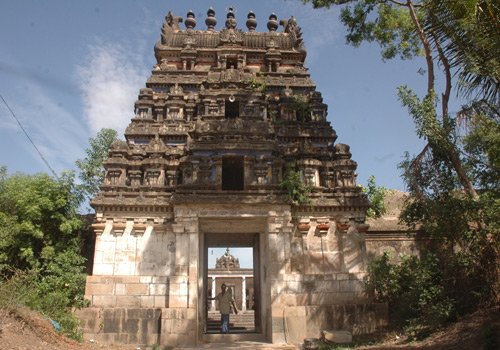This temple is the 19th sthalam on the northern side of River Cauvery. Saints Sambandar, Appar and Sundarar have sung hymns in praise of Lord Shiva of this temple. This is a Padal Petra Sthalam.
Shrine’s History
History has it that Sage Jamadagni could not excuse his wife Renuka for appreciating the handsomeness of a Gandharva whom she saw in the shadow of water. He ordered his son Sage Parasurama to chop off her head. The son obeyed his commands immediately. Later he sought a boon from his father to get his mother back. Father too obliged. Both father and son came to this place, worshipped Lord Shiva for relief from the sin of killing Renukadevi. The Lord appeared before both and cleansed them of their sins. Mother Mahalakshmi also worshipped Lord Shiva here. As the Mother is worshipped here the place is known as Tirunindravur.

Legends Associated with This Shrine
The legend goes that the Sanskrit name for this spot is Varthi Nirvapanapuram, which implies Tirininravur in Tamil. Tiri implies wick and ninravur implies a place where it was put off. A Chola King used to go through Thiruninriyur consistently in the wake of worshiping at Sirkali. As he was going through this town, the lights conveyed by his company used to go off. Fascinated, he needed to look at it and went to the same spot in the morning. He saw Kamadhenu plunging into the timberland. He continued to the spot where Kamadhenu had plunged. He cleared the shrubs with his sword and advanced through the brush. At the same time, his sword hit something and he saw blood growing from that specific spot. He recognised a Shiva Lingam in the undergrowth, from which the blood was overflowing. The opening that the Chola King incidentally made on top of the Shiva Lingam is still seen. He assembled a sanctuary at the same spot which is presently Lakshmipureeswarar Temple at Thiruninriyur.
Architectural Relevance of This Shrine
This temple has a 3 tier Rajagopuram. Lord Vinayaka in the temple is praised as Selva Ganapathy gracing in the prakara. Pujas are performed to Him on Anusha star day. Those facing debt burdens pray to Vinayaka for relief. Muyalagan the symbol of ignorance under the feet of Lord Dakshinamurthy is on the left side with a serpent in his hand. There is a shrine for Lord Muruga gracing with His consorts Valli and Deivanai on His peacock vehicle. This is an East facing Mada temple, meaning it is built on a raised platform. The main deity is Lakshmipureeswarar and his Consort is Ulaganayaki. The Lingam here is one of the 64 Swayambhu Lingams. Lakshmi and Vishnu have worshipped Lord Shiva here. Lakshmi was granted the boon of winning Vishnus heart, hence the name Lakshmipureeswaraar. Lord Shiva here is known as Mahalakshmeesar also. There are separate shrines for Vinayakar, Murugan, Mahalakshmi, the Navagrahas, Bhairavar, Chandran and the Shivalingam worshipped by Parasurama. This temple is to be visited for gaining Kubera Sampathu or prosperity. While Kubera is the Lord of Wealth and is responsible for the distribution of the same, Goddess Lakshmi is the creator of wealth. In other words, Kubera is the treasurer while the Goddess is the CFO.
Shrine’s Map Location and How to Go There
By Road
The nearest bus stop is 7 km from Mayiladuthurai on the Sirkali route.
By Rail
The nearest railway station is Thanjavur.
By Air
The closest airports are in Trichy and Chennai
Shrine Timings
The temple is open from 6.00 a.m. to 11.00 a.m. and from 4.00 p.m. to 8.00 p.m.
Events Celebrated at This Shrine
Aani Tirumanjanam in June-July, Mahashivrathri in February-March and Tirukarthikai in November-December are the festivals celebrated in the temple.
Extra Information About this Shrine
People approach this temple with various prayers. There are three tanks around the temple as a garland praised as Neela Malar Poigai by Saint Sambandar.Those praying here will have a peaceful life free of ailments, fear and sins, it is believed. Devotees perform abishek to Lord Shiva with Madhulai fruit pearls. As Mother Mahalakshmi worshipped Lord Shiva here and was blessed, the Lord is praised as Mahalakshmeeswarar.













































